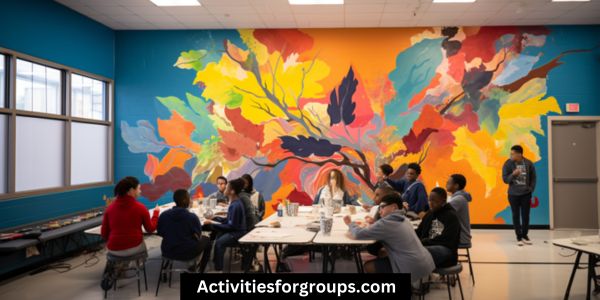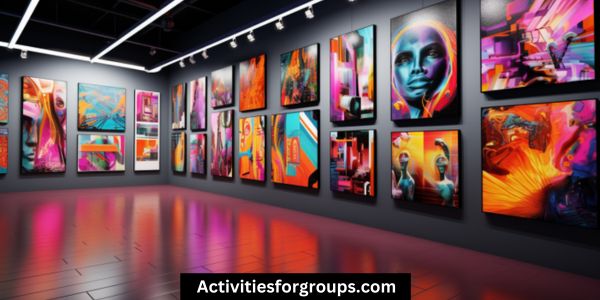Creating group art projects can be a great way to bring people together. But how do you evaluate their success and effectiveness?
This article will walk you through the steps of assessing goals, measuring outcomes, gauging participation, examining results, and reflecting on the process.

Learn how to evaluate group art projects and make sure your project is a success!
Assess Goals
To accurately assess the success and effectiveness of a group art project, start by determining what the goals were. When brainstorming the benefits of undertaking a group project, consider the potential for creative collaboration and the value of shared resources. Note that the goals should be specific and measurable, as this will make it easier to track progress and success.
Make sure that everyone involved in the project is working towards the same goal, and that the goal is achievable with the resources and time available. If the goal isn’t realistic, it may be necessary to adjust it or create new objectives.
It’s also essential to evaluate the process of the project, including how the group worked together and what strategies were used to achieve the goals.
Measure Outcomes
Once the goals have been established, the next step is to measure the outcomes of the group art project.
To do this, it is important to engage stakeholders, review objectives, and assess the impact of the project. This can be done in a variety of ways, such as surveys, interviews, or feedback forms.
When assessing the outcomes of a group art project, it is important to consider both quantitative and qualitative factors. Quantitative data can include the number of participants, the amount of time spent on the project, or the amount of money invested.
Qualitative data can involve assessing the overall quality of the artwork, the level of engagement of the participants, and the satisfaction of the stakeholders.
| Quantitative Factors | Qualitative Factors |
|---|---|
| Number of Participants | Quality of Artwork |
| Amount of Time | Level of Engagement |
| Amount of Money | Satisfaction of Stakeholders |
Gauge Participation
Gauging participation is an important part of assessing the success and effectiveness of a group art project. Participation can be evaluated in terms of the time, energy, and effort put in by each individual. It’s also important to consider the degree to which participants collaborated, communicated with one another, and showed mutual respect.
To measure participation, it’s helpful to keep track of the number of people who actively contributed to the project. It’s also important to note the amount of time each participant spent on the project and how long it took to complete it.
Additionally, it’s helpful to ask for feedback from participants on their experience. This can be done through surveys, focus groups, or interviews.
Another way to measure participation is to collect evidence of everyone’s contributions to the project.
This could include things like emails, notes, drawings, or other types of documentation. By keeping track of these items, it’s possible to get a sense of who did what and how much effort was put into the project.
Examine Results
Once participation has been gauged, it’s important to examine the results of the group art project. Examining the results involves an interactive discussion and collective feedback among the participants. This is the time to identify the successes and failures of the project.
It’s also the time to discuss what went right, what went wrong, and how the project can be improved for future endeavors.
Participants should be encouraged to provide honest and constructive feedback. This can help to identify areas for improvement and develop a plan for the next project. Sharing successes and challenges can also help to create an atmosphere of learning and growth.
When examining results, it’s important to be mindful of the feelings of the participants. It’s essential to be respectful of each person’s contribution, even if it differs from what the group was expecting. This can help to create a safe and collaborative environment.
Finally, it’s important to recognize individual and collective accomplishments. Acknowledging the efforts of the participants can help to motivate them for future projects. It also helps to foster a sense of pride and ownership in the project.
Evaluating the success and effectiveness of group art projects is an important step in creating a successful and meaningful experience for everyone involved. By examining results, providing honest feedback, and celebrating accomplishments, the participants can gain valuable insight into the project.
Reflect on Process

Take the time to reflect on the process of the group art project. It’s important to evaluate the team dynamics, communication, and effectiveness of the project to determine its success. Here are three key steps to consider when reflecting on the process:
- Review the roles and responsibilities of each group member. Analyze how each team member contributed to the project and identify areas of strength and weakness.
- Assess the methods of communication used by the team. Determine if there was an effective flow of information between members and if any misunderstandings occurred.
- Evaluate the overall satisfaction of the group. Consider the overall experience of the project and if the team was happy with the results.
Reflecting on the process of a group art project is an important step to help ensure the success of future projects. Doing so can help identify areas for improvement and set the team up for success in the future.
Frequently Asked Questions
How Much Time Should Be Allocated to a Group Art Project?
You should allocate enough time to brainstorm ideas and assess team dynamics. Consider the size of the group and the complexity of the project.
What Materials Should Be Used for the Project?
Evaluate costs and sharing resources when deciding what materials to use for the project. Consider what’s available, budget-friendly, and works best for the group.
How Should the Group Decide on the Project’s Design?
Brainstorm together, using creative collaboration and different brainstorming strategies to decide on the project’s design.
What Is the Best Way to Motivate the Group to Work Together?
Encourage positive reinforcement and collaboration dynamics to motivate the group. Praise each other’s efforts and reinforce their successes. Show appreciation for everyone’s contributions and foster a sense of teamwork.
How Should the Project Be Evaluated for Success?
Assess the project’s success by evaluating criteria, group dynamics, and overall effectiveness.
Conclusion
Evaluating the success of group art projects can be challenging. However, there are several key steps that can be taken to gain a better understanding of the project’s success and effectiveness.
Firstly, it is important to assess the goals of the project. This involves clearly defining what the project set out to achieve and determining whether these goals were met. By evaluating the extent to which the project aligned with its intended objectives, you can gauge its overall success.
Measuring outcomes is another crucial step in evaluating a group art project. This involves examining the tangible results of the project, such as the final artwork or any other products that were created. By assessing the quality and impact of these outcomes, you can gain insights into the project’s effectiveness.
Gauging participation is also an important aspect of evaluating group art projects. This involves considering the level of engagement and involvement of all participants, including both artists and other stakeholders. By assessing the extent to which everyone contributed to the project, you can determine whether it was a collaborative effort and whether it achieved its intended level of inclusivity.
Examining results is another key step in evaluating the success of a group art project. This involves analyzing any data or feedback collected during or after the project, such as surveys or comments from participants. By reviewing this information, you can gain insights into the project’s impact and identify any areas for improvement.
Finally, reflecting on the process is crucial for evaluating the success of a group art project. This involves considering the overall journey of the project, including the planning, execution, and any challenges encountered along the way. By reflecting on the process, you can gain a deeper understanding of what worked well and what could be improved for future projects.
In conclusion, evaluating the success of group art projects requires a comprehensive assessment of goals, outcomes, participation, results, and the overall process. By taking the time to evaluate these factors, you can gain valuable insights and improve future projects.




Leave a Reply